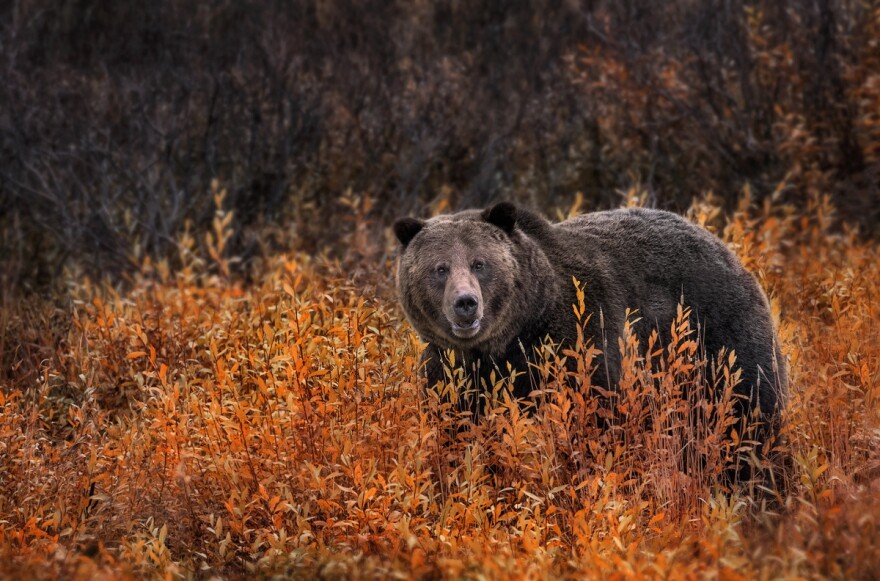Today's Moment of Science "digs up" the story behind one of the grizzly bear's more unusual nicknames: the "Rototiller of the Rockies."
To begin, let's talk claws. Grizzly bear claws are huge--usually three to four inches long. This is perfect for an animal who survives by digging around in the landscape, unearthing tasty treats like ground squirrels and root vegetables.
So, they basically have rototiller blades attached to their paws!
One of the grizzly bear's favorite early-season foods is the glacier lily, a beautiful yellow flower with a starchy, nutritious bulb. Bears "till" up the land, turning over chunks of soil to access those tasty bulbs. Scientists working in Glacier National Park, Montana have learned that this "tilling" has some important side effects. Areas with recent bear diggings have less plant diversity and higher nitrogen levels than undisturbed parts of the landscape. Without much competition from other plants, left-behind glacier lily bulbs can quickly regenerate, and these new lilies produce twice the usual number of seeds, thanks to the nitrogen-rich soil.
Glacier lilies aren't the only things to benefit from those "rototiller" grizzlies.
We humans have also gained important culinary knowledge. You see, after digging up glacier lilies, bears often leave the bulbs for a few days to wilt in the sun. This "cooks" them a bit, and makes them sweeter and easier to digest. First Nations lore shows that early peoples learned to dry and cook glacier lily bulbs by copying the grizzly bear.
So maybe we'll have to add "expert chef" to the grizzly's list of nicknames!
Read more
Sources
- Doak, Daniel F. and Michael G. Loso. "Effect of Grizzly Bear Digging on Alpine Plant Community Structure." Arctic, Antactic and Alpine Research. 35:4 (2003), 421-8
- Tardiff, Sandra E. and Jack A. Stanford. "Grizzly Bear Digging: Effects on Subalpine Meadow Plants in relation to Mineral Nitrogen Availability." Ecology. 9:7 (1998), 2219-29
- Turner, Nancy J., Marianne Boelscher Ignace and Ronald Ignace. "Traditional Ecological Knowledge and Wisdom of Aboriginal Peoples in British Columbia." Ecological Applications. 10:5 (2000), 1275-87
Y: Today's Moment of Science "digs up" the story behind one of the grizzly bear's more unusual nicknames: the "Rototiller of the Rockies."
D: And we'll also learn a bit about the grizzly's little-known culinary talents.
Y To begin, let's talk claws. Grizzly bear claws are huge--usually three to four inches long. This is perfect for an animal who survives by digging around in the landscape, unearthing tasty treats like ground squirrels and root vegetables.
D: Aha! So, they basically have rototiller blades attached to their paws!
Y: Exactly. One of the grizzly bear's favorite early-season foods is the glacier lily, a beautiful yellow flower with a starchy, nutritious bulb. Bears "till" up the land, turning over chunks of soil to access those tasty bulbs. And guess what: scientists working in Glacier National Park, Montana have learned that this "tilling" has some important side effects. Areas with recent bear diggings have less plant diversity and higher nitrogen levels than undisturbed parts of the landscape. Without much competition from other plants, left-behind glacier lily bulbs can quickly regenerate, and these new lilies produce twice the usual number of seeds, thanks to the nitrogen-rich soil!
D: Neat! But remember, glacier lilies aren't the only things to benefit from those "rototiller" grizzlies.
Y: They're not?
D: Nope. We humans have also gained important culinary knowledge. You see, after digging up glacier lilies, bears often leave the bulbs for a few days to wilt in the sun. This "cooks" them a bit, and makes them sweeter and easier to digest. First Nations lore shows that early peoples learned to dry and cook glacier lily bulbs by copying the grizzly bear.
Y: Wow! I guess we'll have to add "expert chef" to the grizzly's list of nicknames!


